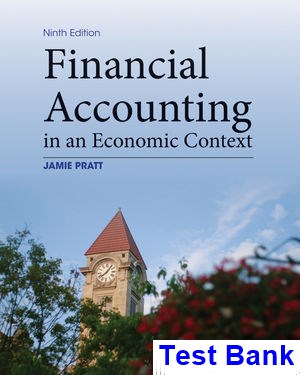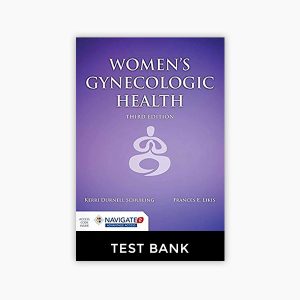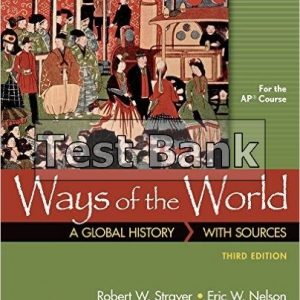Financial Accounting in an Economic Context 9th Edition Pratt Test Bank

Product details:
- ISBN: 9781118582558
- Author: Pratt
By focusing on three elemental themes — economic factors, measurement issues, and decision-making perspective — Jamie Pratt’s Financial Accounting in an Economic Context, 9th Edition provides a clear understanding of the relevance of principles applied in the real world. Virtually every concept refers to a real company, a real situation, or a real event. Pratt 9e takes an integrative look at accounting and finance by considering the impact of economics, internal controls, international standard, ethics, decision-making, and earnings management. A complete financial picture can be drawn using the tools presented in this text. This text enables MBA and undergraduate students to develop an understanding of the impact that economic events have on business. New elements in the ninth edition sharpen the text’s economic decision-making foundation and is available with Quantum’s intelligent adaptive learning and assessment software.
Table contents:
-
- CHAPTER 1: Financial Accounting and Its Economic Context
- 1.1 Financial Reporting and Investment Decisions
- 1.2 The Demand for Financial Information: A User’s Orientation
- 1.3 The Economic Environment in which Financial Reports Are Prepared and Used
- 1.4 Corporate Governance
- 1.5 International Perspective: Movement toward a Single Global Financial Reporting System
- APPENDIX 1A
- SUMMARY OF KEY POINTS
- KEY TERMS
- INTERNET RESEARCH EXERCISE
- ISSUES FOR DISCUSSION
- CHAPTER 2: The Financial Statements
- 2.1 Capital Flows and Operating, Investing, and Financial Activities
- 2.2 The Classified Balance Sheet
- 2.3 The Income Statement
- 2.4 The Statement of Shareholders’ Equity
- 2.5 The Statement of Cash Flows
- 2.6 Relationships among the Financial Statements
- 2.7 International Perspective: An Example of International Financial Reporting Standards
- REVIEW PROBLEM
- SUMMARY OF KEY POINTS
- KEY TERMS
- INTERNET RESEARCH EXERCISE
- BRIEF EXERCISES
- EXERCISES
- PROBLEMS
- ISSUES FOR DISCUSSION
- CHAPTER 1: Financial Accounting and Its Economic Context
- PART 2: Measurement, Mechanics, and Use of Financial Statements
- CHAPTER 3: The Measurement Fundamentals of Financial Accounting
- 3.1 Assumptions of Financial Accounting
- 3.2 Valuations on the Balance Sheet
- 3.3 The Principles of Financial Accounting Measurement
- 3.4 Two Exceptions to the Basic Principles: Materiality and Conservatism
- 3.5 International Perspective: Fundamental Differences between U.S. GAAP and IFRS
- SUMMARY OF KEY POINTS
- KEY TERMS
- INTERNET RESEARCH EXERCISE
- BRIEF EXERCISES
- EXERCISES
- PROBLEMS
- ISSUES FOR DISCUSSION
- CHAPTER 4: The Mechanics of Financial Accounting
- 4.1 Economic Events
- 4.2 The Fundamental Accounting Equation
- 4.3 Business Transactions, the Accounting Equation, and the Financial Statements
- 4.4 The Journal Entry
- 4.5 Recognizing Gains and Losses
- 4.6 Periodic Adjustments
- 4.7 Reporting Difficulties Faced by Multinational Companies
- APPENDIX 4A
- T-Account Analysis and Preparing the Statement of Cash Flows
- OPERATING ITEMS
- REVIEW PROBLEM
- SUMMARY OF KEY POINTS
- KEY TERMS
- INTERNET RESEARCH EXERCISE
- BRIEF EXERCISES
- EXERCISES
- PROBLEMS
- ISSUES FOR DISCUSSION
- CHAPTER 5: Using Financial Statement Information
- 5.1 Control and Prediction
- 5.2 Framework for Using Financial Statements to Predict Future Earnings and Cash Flows
- 5.3 Elements of Financial Statement Analysis
- 5.4 Assessing the Business Environment
- 5.5 Reading and Studying the Financial Statements and Footnotes
- 5.6 Assessing Earnings Quality
- 5.7 Analyzing the Financial Statements
- 5.8 Predict Future Earnings and/or Cash Flow
- 5.9 Annual Report Information and Predicting Stock Prices
- 5.10 International Perspective: Financial Statement Analysis in an International Setting
- APPENDIX 5A
- Shareholder Value, ROE, and Cash Flow Analyses
- Determinants of Value Creation: Analyzing Return on Equity
- Shareholder Value Creation and the ROE Model: Macy’s vs. Kohl’s
- Cash Flow Analysis
- Cash Flow Profiles
- Projecting Future Financial Statements
- REVIEW PROBLEM
- SUMMARY OF KEY POINTS
- KEY TERMS
- INTERNET RESEARCH EXERCISE
- BRIEF EXERCISES
- EXERCISES
- PROBLEMS
- ISSUES FOR DISCUSSION
- CHAPTER 3: The Measurement Fundamentals of Financial Accounting
- PART 3: Assets: A Closer Look
- CHAPTER 6: The Current Asset Classification, Cash, and Accounts Receivable
- 6.1 The Current Asset Classification
- 6.2 Cash
- 6.3 Accounts Receivable
- 6.4 Accounts Receivable from a User’s Perspective
- 6.5 International Perspective: Receivables, Foreign Currencies, and Hedging
- ROE EXERCISE: Management of Working Capital and Receivables and Return on Equity
- REVIEW PROBLEM
- SUMMARY OF KEY POINTS
- KEY TERMS
- INTERNET RESEARCH EXERCISE
- BRIEF EXERCISES
- EXERCISES
- PROBLEMS
- ISSUES FOR DISCUSSION
- CHAPTER 7: Merchandise Inventory
- 7.1 The Relative Size of Inventories
- 7.2 Accounting for Inventory: Four Important Issues
- 7.3 Acquiring Inventory: What Costs to Capitalize?
- 7.4 Carrying Inventory: Perpetual Method
- 7.5 Selling Inventory: Which Cost Flow Assumption?
- 7.6 Ending Inventory: Applying the Lower-of-Cost-or-Market Rule
- 7.7 The Lower-of-Cost-or-Market Rule and Hidden Reserves
- 7.8 International Perspective: Japanese Business and Inventory Accounting
- ROE EXERCISE: Management of Inventory and Return on Equity
- REVIEW PROBLEM
- SUMMARY OF KEY POINTS
- KEY TERMS
- INTERNET RESEARCH EXERCISE
- BRIEF EXERCISES
- EXERCISES
- PROBLEMS
- ISSUES FOR DISCUSSION
- CHAPTER 8: Investments in Equity Securities
- 8.1 Equity Securities Classified as Current
- 8.2 Trading and Available-for-Sale Securities
- 8.3 Long-Term Equity Investments
- ROE EXERCISE: Managing Investments in Equity Securities and Return on Equity
- APPENDIX 8A
- Consolidated Financial Statements
- REVIEW PROBLEM I
- REVIEW PROBLEM II
- SUMMARY OF KEY POINTS
- KEY TERMS
- INTERNET RESEARCH EXERCISE
- BRIEF EXERCISES
- EXERCISES
- PROBLEMS
- ISSUES FOR DISCUSSION
- CHAPTER 9: Long-Lived Assets
- 9.1 The Relative Size of Long-Lived Assets
- 9.2 Long-Lived Asset Accounting: General Issues and Financial Statement Effects
- 9.3 An Overview of Long-Lived Asset Accounting
- 9.4 Acquisition: What Costs to Capitalize?
- 9.5 Postacquisition Expenditures: Betterments or Maintenance?
- 9.6 Cost Allocation: Amortizing Capitalized Costs
- 9.7 Disposal: Retirements, Impairments, Sales, and Trade-Ins
- 9.8 Intangible Assets
- 9.9 Copyrights, Patents, and Trademarks
- 9.10 The Costs of Developing Computer Software
- 9.11 Goodwill
- 9.12 Organizational Costs
- 9.13 Research and Development Costs
- 9.14 IFRS vs. U.S. GAAP: Revaluations to Fair Market Value
- ROE EXERCISE: Managing Long-Lived Assets and Return on Equity
- REVIEW PROBLEM
- SUMMARY OF KEY POINTS
- KEY TERMS
- INTERNET RESEARCH EXERCISE
- BRIEF EXERCISES
- EXERCISES
- PROBLEMS
- ISSUES FOR DISCUSSION
- CHAPTER 6: The Current Asset Classification, Cash, and Accounts Receivable
- PART 4: Liabilities and Shareholders’ Equity: A Closer Look
- CHAPTER 10: Introduction to Liabilities: Economic Consequences, Current Liabilities, and Contingencies
- 10.1 What Is a Liability?
- 10.2 The Relative Size of Liabilities on the Balance Sheet
- 10.3 Reporting Liabilities on the Balance Sheet: Economic Consequences
- 10.4 Current Liabilities
- 10.5 Determinable Current Liabilities
- 10.6 Contingencies and Contingent Liabilities
- 10.7 Provisions vs. Contingent Liabilities: The “Devil Is in the Details”
- ROE EXERCISE: Managing Current Liabilities
- APPENDIX 10A
- Retirement Costs: Pensions and Postretirement Healthcare and Insurance
- Pensions
- Defined Contribution Plan
- Defined Benefit Plan
- Postretirement Healthcare and Insurance Costs
- APPENDIX 10B
- Deferred Income Taxes
- The Concept of Deferred Income Taxes
- Accounting Entries for Deferred Income Taxes
- Deferred Income Taxes: Additional Issues
- The Conservatism Ratio
- REVIEW PROBLEM
- SUMMARY OF KEY POINTS
- KEY TERMS
- INTERNET RESEARCH EXERCISE
- BRIEF EXERCISES
- EXERCISES
- PROBLEMS
- ISSUES FOR DISCUSSION
- CHAPTER 11: Long-Term Liabilities: Notes, Bonds, and Leases
- 11.1 The Relative Size of Long-Term Liabilities
- 11.2 The Economic Consequences of Reporting Long-Term Liabilities
- 11.3 Basic Definitions and Different Contractual Forms
- 11.4 Effective Interest Rate
- 11.5 Accounting for Long-Term Obligations: The Effective Interest Method
- 11.6 Accounting for Long-Term Notes Payable
- 11.7 Bonds Payable
- 11.8 Financial Instruments, Fair Market Values, and Off-Balance Sheet Risks
- 11.9 Leases
- 11.10 International Perspective: The Importance of Debt Financing in Other Countries
- ROE EXERCISE: Managing Long-Term Debt
- APPENDIX 11A
- The Determination of Bond Prices
- APPENDIX 11B
- Investing in Bonds
- APPENDIX 11C
- Interest Rate Swaps and Hedging
- REVIEW PROBLEM
- Cash Flow Calculations
- Journal Entry Calculations
- Discount Balance and Balance Sheet Value of Bonds Payable
- SUMMARY OF KEY POINTS
- KEY TERMS
- INTERNET RESEARCH EXERCISE
- BRIEF EXERCISES
- EXERCISES
- PROBLEMS
- ISSUES FOR DISCUSSION
- CHAPTER 12: Shareholders’ Equity
- 12.1 The Relative Importance of Liabilities, Contributed Capital, and Earned Capital
- 12.2 Debt and Equity Distinguished
- 12.3 The Economic Consequences Associated with Accounting for Shareholders’ Equity
- 12.4 Accounting for Shareholders’ Equity
- 12.5 Accounting for Common and Preferred Stock Issuances
- 12.6 The Statement of Shareholders’ Equity
- 12.7 International Perspective: The Rise of International Equity Markets
- ROE EXERCISE: Return on Equity and Value Creation
- REVIEW PROBLEM
- SUMMARY OF KEY POINTS
- KEY TERMS
- INTERNET RESEARCH EXERCISE
- BRIEF EXERCISES
- EXERCISES
- PROBLEMS
- ISSUES FOR DISCUSSION
- CHAPTER 10: Introduction to Liabilities: Economic Consequences, Current Liabilities, and Contingencies
- PART 5: Income and Cash Flows
- CHAPTER 13: The Complete Income Statement
- 13.1 The Economic Consequences Associated with Income Measurement and Disclosure
- 13.2 The Measurement of Income: Different Measures for Different Objectives
- 13.3 A Complete Income Statement: Disclosure and Presentation
- 13.4 Intraperiod Tax Allocation
- 13.5 Earnings-Per-Share Disclosure
- 13.6 Income Statement Categories: Useful for Decisions but Subjective
- 13.7 International Perspective: Investments and Income Statement Disclosure
- ROE EXERCISE: Using the Right Earnings Number
- REVIEW PROBLEM
- SUMMARY OF KEY POINTS
- KEY TERMS
- INTERNET RESEARCH EXERCISE
- BRIEF EXERCISES
- EXERCISES
- PROBLEMS
- ISSUES FOR DISCUSSION
- CHAPTER 14: The Statement of Cash Flows
- 14.1 The Definition of Cash
- 14.2 A General Description of the Statement of Cash Flows
- 14.3 How the Statement of Cash Flows Can Be Used
- 14.4 The Statement of Cash Flows: Economic Consequences
- 14.5 Deriving Cash Flow from Accrual Financial Statements
- 14.6 The Complete Statement of Cash Flows
- 14.7 Analyzing the Statement of Cash Flows: An Application
- 14.8 International Perspective: The Statement of Cash Flows
- REVIEW PROBLEM
- SUMMARY OF KEY POINTS
- KEY TERMS
- INTERNET RESEARCH EXERCISE
- BRIEF EXERCISES
- EXERCISES
- PROBLEMS
- ISSUES FOR DISCUSSION
- APPENDIX A: The Time Value of Money
- Interest: The Price of Money
- Time Value
- Time Value Computations
- Computing Implicit Rates of Return and Interest Rates
- Present Value and Financial Accounting
- EXERCISES
- PROBLEMS
- APPENDIX B: Quality of Earnings Cases: A Comprehensive Review
- Case 1: Liberty Manufacturing
- Case 2: Microline Corporation
- Case 3: Technic Enterprises and Sonar-Sun Inc.
- Case 4: Avery Corporation
- Case 5: Zenith Creations
- Case 6: Pierce and Snowden
- CHAPTER 13: The Complete Income Statement
- Glossary
- Subject Index
- Company Index
People also search:





